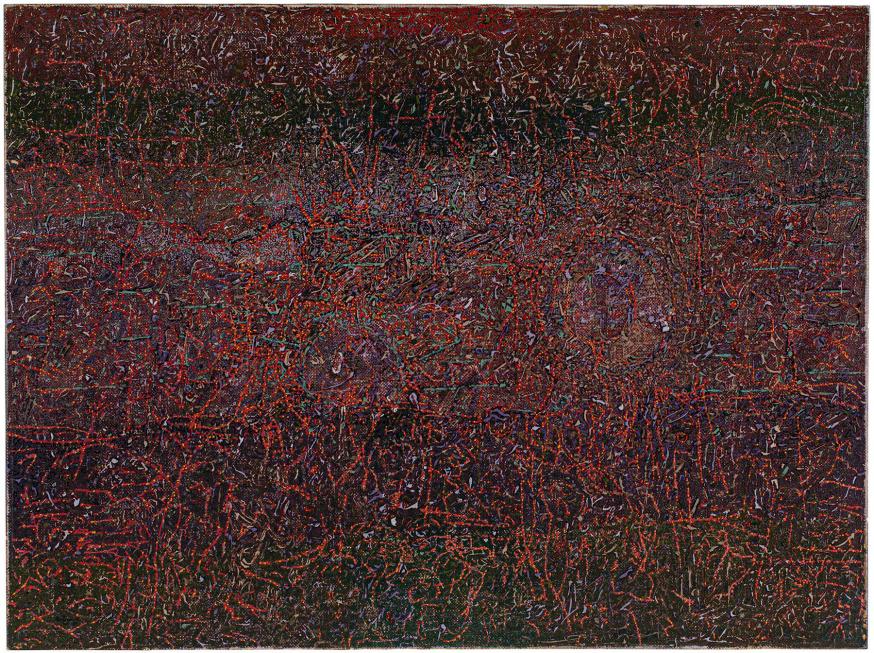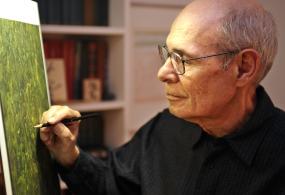Charles Seliger
1926–2009


Charles Seliger in his home studio, 2008; Photographer Mark Seliger, Courtesy of the Estate of Charles Seliger
All artworks displayed above are currently available. To inquire about additional works available by this artist, please contact the gallery.
Biography
I want to apostrophize micro-reality. I want to tear the skin from life, and, peering closely, paint what I see. I want my brain to become a magnifying lens for the infinite minutiae forming reality. Growth is the poetry of all art.
A member of the first generation of abstract expressionists, the work of Charles Seliger reflects his lifelong interest in the hidden inner workings and structures of the natural world. Seliger was largely self-taught and was particularly influenced by the ideas of the surrealist artists in exile in New York during World War II. Developing some of their ideas into his own, Seliger sought to convey the dynamics of chaos, order and flux which comprise nature on both the microcosmic and macrocosmic spheres.
Born Charles Marvin Zekowski in New York City in 1926, Charles Seliger had a turbulent childhood during which he moved frequently due to the precarious finances of his divorced parents. In 1940, Charles and his mother, Hortense Seliger, moved to Jersey City, and Charles Zekowski took his mother’s surname, becoming Charles Seliger. While living in New Jersey, Seliger made frequent trips across the Hudson to see Manhattan’s many museum and gallery exhibitions, often with friend and artist Herman Zaage, who taught at the New School for Social Research. In 1941, Seliger moved to Baltimore, where his mother had found employment. Seliger learned how to hand-color and airbrush photographs, which earned him a job at a department store.
Although he never completed high school or received formal art training, Seliger immersed himself in the history of art and experimented with different painting styles including pointillism, cubism, and surrealism. In 1942, he participated in a group exhibition organized by the Painters and Sculptors Society of New Jersey. In 1943, Seliger befriended Jimmy Ernst and was quickly drawn into the circle of avant-garde artists championed by Howard Putzel and Peggy Guggenheim. Two years later, at the age of nineteen, Seliger was included in Putzel’s groundbreaking exhibition A Problem for Critics at 67 Gallery, and he also had his first solo exhibition, at Guggenheim’s legendary Art of This Century. Seliger became the youngest artist exhibiting with the abstract expressionists, and he was twenty years old when the Museum of Modern Art acquired his painting Natural History: Form within Rock (1946) for their permanent collection. In 1949, Seliger had his first major museum exhibition, at the De Young Memorial Museum, San Francisco, and a year later, he joined the stable of artists at the prestigious Willard Gallery, owned by Marian Willard. He formed close friendships with several of her other artists, including Mark Tobey, Lyonel Feininger, and Norman Lewis.
While Seliger was closely associated with abstract expressionism, he also challenged its parameters, as Francis O’Connor and Michelle DuBois have noted. Where abstract expressionists pursued the painted gesture on large canvases, the traces of Seliger’s presence came from the exquisite details of the infinitely vast worlds he created on small canvases—evidence of the patience, discipline, and imagination of their creator. Possessed of an expansive intellect and generous spirit, Seliger pursued an inner world of organic abstraction, celebrating the structural complexities of natural forms. Attracted to the internal structures of plants, insects, and other natural objects, and inspired by a wide range of literature in natural history, biology, and physics, Seliger paid homage to nature’s infinite variety in his abstractions. His paintings have been described as “microscopic views of the natural world,” and although the characterization is appropriate, his abstractions do not directly imitate nature so much as suggest its intrinsic structures.
In the 1970s, Seliger began cutting his canvases from the stretcher and applying gesso and acrylic washes before laboriously tracing lines with a fine ink brush. In the late 1970s, he began his “excavations”—a series of drawings using gesso, graphite, brushed paint, and a tjanting tool, which allowed him to apply hot wax to his works in a fine, controlled line. In the 1980s, Seliger began to work extensively on the Masonite paintings for which he became famous—as much for the processes he invented to achieve them as for the finished works. Building up layers of acrylic paint and often sanding or scraping each layer to create texture, Seliger would then delineate the forms embedded in the layers of pigment with a fine brush or pen. This labor-intensive technique resulted in ethereal paintings that give expression to aspects of nature hidden from or invisible to the unaided eye; they recall the automatism of surrealism as well as the importance of the accidental to abstract expressionism.
During his lifetime, Seliger exhibited in over forty-five solo shows at prominent galleries in New York and abroad. But it was not until 1986, that he was given his first retrospective, at the Solomon R. Guggenheim Museum, which now holds the largest collection of his work. In 2003, at age seventy-seven, Seliger received the Pollock-Krasner Foundation’s Lee Krasner Award in recognition of his long and illustrious career in the arts. Also in 2003, he was the subject of the retrospective, Charles Seliger: Sixty Years of Abstraction at Greeneville County Museum of Art in Greeneville, SC. In 2005, the Morgan Library and Museum acquired his journals—148 hand-written volumes produced between 1952 and the present—making his introspective writing, which covers a vast range of topics across the span of six decades, accessible to art historians and scholars. His work is represented in numerous museum collections, including the Metropolitan Museum of Art, the Museum of Modern Art, and the Whitney Museum of American Art in New York; the Wadsworth Atheneum in Hartford, Connecticut; and the British Museum in London.
Since his death, Seliger has been featured in numerous museum exhibitions. In 2012, The Mint Museum in Charlotte, NC organized the exhibition Seeing the World Within: Charles Seliger in the 1940s which traveled to Peggy Guggenheim Collection in Venice, Italy and Munson-Williams Proctor Art Institute in Utica, NY. A catalogue for the exhibition was published with original scholarship by Dr. Jonathan Stuhlman, Senior Curator of American, Modern, and Contemporary Art at The Mint Museum and Michelle DuBois. Also in 2012, Seliger was included in the group exhibition Signs and Symbols at Whitney Museum of American Art.
Michael Rosenfeld Gallery LLC was the exclusive representative of Charles Seliger from 1990-2014, mounting ten solo exhibitions and publishing eight catalogues for the artist.
Gallery Exhibitions
Press
Publications

